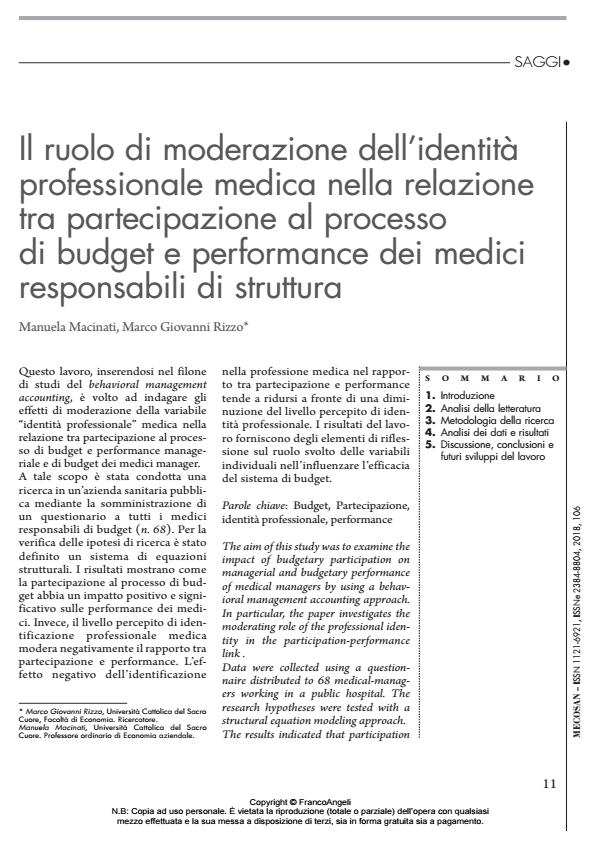Il ruolo di moderazione dell’identità professionale medica nella relazione tra partecipazione al processo di budget e performance dei medici responsabili di struttura
Titolo Rivista MECOSAN
Autori/Curatori Manuela Macinati, Marco Giovanni Rizzo
Anno di pubblicazione 2019 Fascicolo 2018/106
Lingua Italiano Numero pagine 26 P. 11-36 Dimensione file 662 KB
DOI 10.3280/MESA2018-106002
Il DOI è il codice a barre della proprietà intellettuale: per saperne di più
clicca qui
Qui sotto puoi vedere in anteprima la prima pagina di questo articolo.
Se questo articolo ti interessa, lo puoi acquistare (e scaricare in formato pdf) seguendo le facili indicazioni per acquistare il download credit. Acquista Download Credits per scaricare questo Articolo in formato PDF

FrancoAngeli è membro della Publishers International Linking Association, Inc (PILA)associazione indipendente e non profit per facilitare (attraverso i servizi tecnologici implementati da CrossRef.org) l’accesso degli studiosi ai contenuti digitali nelle pubblicazioni professionali e scientifiche
Questo lavoro, inserendosi nel filone di studi del behavioral management accounting, e volto ad indagare gli effetti di moderazione della variabile "identita professionale" medica nella relazione tra partecipazione al processo di budget e performance manageriale e di budget dei medici manager. A tale scopo e stata condotta una ricerca in un’azienda sanitaria pubblica mediante la somministrazione di un questionario a tutti i medici responsabili di budget (n. 68). Per la verifica delle ipotesi di ricerca e stato definito un sistema di equazioni strutturali. I risultati mostrano come la partecipazione al processo di budget abbia un impatto positivo e significativo sulle performance dei medici. Invece, il livello percepito di identificazione professionale medica modera negativamente il rapporto tra partecipazione e performance. L’effetto negativo dell’identificazione nella professione medica nel rapporto tra partecipazione e performance tende a ridursi a fronte di una diminuzione del livello percepito di identita professionale. I risultati del lavoro forniscono degli elementi di riflessione sul ruolo svolto delle variabili individuali nell’influenzare l’efficacia del sistema di budget.
Parole chiave:Budget, Partecipazione, identita professionale, performance
- Orientamento al feedback, soddisfazione rispetto al feedback del sistema reporting e performance di budget Manuela S. Macinati, Marco Giovanni Rizzo, in MANAGEMENT CONTROL 3/2024 pp.179
DOI: 10.3280/MACO2024-003009 - Importanza della conoscenza dell’anatomia umana di educazione fisica Robson Felipe dos Santos Leles, Polyanne Junqueira Silva Andresen Strini, Paulinne Junqueira Silva Andresen Strini, Simone Cristina Putrick, Euzebio Oliveira, Carla Viana Dendasck, in Revista Científica Multidisciplinar Núcleo do Conhecimento 65532/2017 pp.21
DOI: 10.32749/nucleodoconhecimento.com.br/salute/anatomia-umana - Soddisfazione lavorativa e work engagement nelle budgeting practices delle aziende sanitarie pubbliche. Una verifica empirica Domenico Raucci, Manuela Paolini, in MANAGEMENT CONTROL 1/2021 pp.13
DOI: 10.3280/MACO2021-001002
Manuela Macinati, Marco Giovanni Rizzo, Il ruolo di moderazione dell’identità professionale medica nella relazione tra partecipazione al processo di budget e performance dei medici responsabili di struttura in "MECOSAN" 106/2018, pp 11-36, DOI: 10.3280/MESA2018-106002